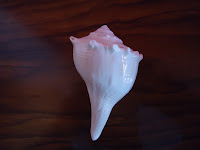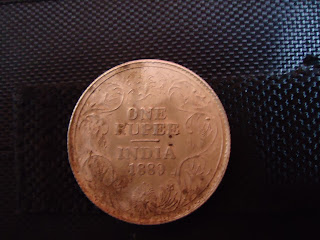I was interested to know of what the begging bowl that was presented to Shanthamma at the December's Homa Ceremonies by Sai Baba was constituted. He had referred to it as Kapaala and told her that it was earlier with Shiva and that it later came to him which he presented it to Shanthamma. Shanthamma said that it was most probably the skull of some animal. I give another close-up photograph of the bowl alongside:
In addition to this begging bowl, a tiny pendant of Sai Baba and another tiny pendant of a Shiva Linga with a hooded snake perhaps made of silver was also in the bundle. The photograph is given alongside:
Every year, for the past five or six years, the members of our Bhajan Group proceed on some pilgrimage. In this effort we get to visit some out of the places that are not within easy reach of the common Bangalorean. In the year 2007 we visited Kuruvanthpura. In 2008 we visited Pithapuram. The year 2009 ended in a fiasco due to the Telengana riots in the vicinity of Hyderabad. In the year 2010 the group visited Ganagapura, Kudala Sangama, Badami, Aihole etc.
The past year in December 2011 we visited Nanded (Gurudwara established by the tenth guru Guru Gobind Singh) and later we proceeded to Karanja in Akola district of Maharshtra. This tiny town is the place where Shri Narasimha Saraswathi, the second Datta Avatar in Kali yuga, was born. By a phenomenal coincidence, when we were at that town, the birthday celebrations of the saint was held. Shri Narasimha Saraswathi gave a darshan to Shanthamma and donated a golden coin about the size and thickness of a Fifty Paise coin.
This coin has 'Saraswathi' inscribed on one side and 'Sri Nusita Saraswathi' inscribed on the other. Both the letters are in Devanagari script as can be seen in the two photographs. Shanthamma was told that it was the Saint's contribution, or more precisely, his 'Bhiksha' to the Kapaala or Begging Bowl.
While at the same place Karanja, Sai Baba again gave a darshan to Shanthamma and gifted her a bundle containing a pair of wooden padukas, a brass Kamandala (a vessel with a spout from which sanyasis drink water), an attractive creamy-white shell, a dark olive green well rounded polished elliptical semi-transparent pebble shaped stone (a linga? Saligrama?), cowrie shells etc. (See photo)
The shell (conch?) is generally used to perform 'Abhisheka' - a ritual bath of a linga. Two views of the conch are given here.
A set of ten seashells which are called 'Kavade' in Kannada (Cowrie) and was traditionally used by children to play various games - even I remember playing them with my sister and neighbourhood children as a boy of seven or eight years - was also enclosed in a saffron bag. We haven't yet understood the importance of these gifts or what they are supposed to signify. Baba presented these items in a bundle on December 26th 2011 and advised her to retain it with her for a year and that he would tell her to whom the items should be gifted.
Among other presents of Shirdi Sai Baba to Shanthamma are 1) A silver One rupee coin with the year 1889 on it.
2) A Half Franc coin of France (1970) and a ten paise Indian coin of 1989 and a five paise coin of 1985. There was also a coin of copper but the imprints on it were not very clear. These coins materialised at the Homa and Annadana celebrations at Bangalore.
3) A beautiful polished dark green pebble which some call Saligrama and is considered sacred by the Hindus was also presented by Baba at Karanja.
One possible interpretation (I got this inspiration on 10th October 2012) that a person can give for the gift of cowrie shells (Kavade in Kannada) is that Baba wanted to draw attention to the ancient children's game of Moksha Pata (Lesson of Moksha) which could be played with cowrie shells.
It may even be Baba's intention to draw the attention of us all that life is like the game of Moksh Pata or 'Snakes and Ladders' with the lesson that both 'virtues' and 'vices' that a person has in one's life may be determined by chance as in the children's game where the outcome is determined by probabalities of the outcome of a throw of dice or kavades. So one need not be inordinately proud to be a 'virtuous man' or inordinately be critical of himself if he thinks he has committed a lot of sins and is a sinner. I add that all these are my interpretations.
The board game,
today called Snakes and Ladders, originated in ancient India, where it was
known by the name Mokshapat or Moksha Patamu meaning the 'Lesson to Moksha'. It's not exactly known when or
who invented it, though it's believed the game was played at a time as early as
2nd century BC. According to some historians, the game was invented by Saint
Gyandev in the 13th century AD. Originally, the game was used as a part of
moral instruction to children. The squares in which ladders start were each
supposed to stand for a virtue, and those housing the head of a snake were
supposed to stand for an evil. The snakes outnumbered the ladders in the
original Hindu game. The game was transported to England by the colonial rulers
in the latter part of the 19th century, with some modifications. My wife tells me that in one version of the game, after one reaches the 'Final Square' he then proceeds by steps of one square at a time to reach the end of the game. In these squares by which he proceeds one at a time, there are neither snakes nor ladders. Perhaps it means that one would have reached some sort of 'God Realisation' and performs actions where neither virtues nor vices of those actions stick to him. In other words, he neither views himself as 'virtuous' nor as a 'vice man'. The modified
game was named Snakes and Ladders and stripped of its moral and religious
aspects and the number of ladders and snakes were equalized.
XXX











No comments:
Post a Comment